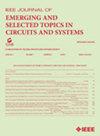HyDe:桥式 PCM/FeFET/SRAM 副搜索,用于优化模拟 IMC 平台的面积和能效
IF 3.7
2区 工程技术
Q2 ENGINEERING, ELECTRICAL & ELECTRONIC
IEEE Journal on Emerging and Selected Topics in Circuits and Systems
Pub Date : 2023-10-26
DOI:10.1109/JETCAS.2023.3327748
引用次数: 0
摘要
如今,有大量的内存计算(IMC)设备--SRAM、PCM 和 FeFET--能以高吞吐量模拟交叉阵列上的卷积。在交叉棒上进行深度神经网络(DNN)推理时,每种 IMC 设备在面积开销、编程能量和非理想性方面都有各自的优缺点。因此,设计空间探索势在必行,以便在多个设备的非理想性影响下,推导出优化的混合设备架构,实现精确的 DNN 推断,同时保持有竞争力的面积和能效。我们提出了一个两阶段搜索框架(HyDe),它利用多种设备提供的各种优势,为给定的 DNN 拓扑确定最佳混合设备架构。对于 VGG16 DNN 拓扑,我们的混合模型比基线同构模型的能效高出 22 - 26%,TOPS/mm^{2}$比基线同构模型高出多达 2.30 - 2.74 倍。我们进一步提出了在 2.5D 设计空间中使用芯片实现 HyDe 衍生混合器件架构的可行方案,以减少涉及多种技术工艺的硬件制造过程中的设计工作量和成本。本文章由计算机程序翻译,如有差异,请以英文原文为准。
HyDe: A brid PCM/FeFET/SRAM vice-Search for Optimizing Area and Energy-Efficiencies in Analog IMC Platforms
Today, there are a plethora of In-Memory Computing (IMC) devices- SRAMs, PCMs & FeFETs, that emulate convolutions on crossbar-arrays with high throughput. Each IMC device offers its own pros & cons during inference of Deep Neural Networks (DNNs) on crossbars in terms of area overhead, programming energy and non-idealities. A design-space exploration is, therefore, imperative to derive a hybrid-device architecture optimized for accurate DNN inference under the impact of non-idealities from multiple devices, while maintaining competitive area & energy-efficiencies. We propose a two-phase search framework (HyDe) that exploits the best of all worlds offered by multiple devices to determine an optimal hybrid-device architecture for a given DNN topology. Our hybrid models achieve upto
$2.30-2.74\times $
higher
$TOPS/mm^{2}$
at 22 – 26% higher energy-efficiencies than baseline homogeneous models for a VGG16 DNN topology. We further propose a feasible implementation of the HyDe-derived hybrid-device architectures in the 2.5D design space using chiplets to reduce design effort and cost in the hardware fabrication involving multiple technology processes.
求助全文
通过发布文献求助,成功后即可免费获取论文全文。
去求助
来源期刊

IEEE Journal on Emerging and Selected Topics in Circuits and Systems
ENGINEERING, ELECTRICAL & ELECTRONIC-
CiteScore
8.50
自引率
2.20%
发文量
86
期刊介绍:
The IEEE Journal on Emerging and Selected Topics in Circuits and Systems is published quarterly and solicits, with particular emphasis on emerging areas, special issues on topics that cover the entire scope of the IEEE Circuits and Systems (CAS) Society, namely the theory, analysis, design, tools, and implementation of circuits and systems, spanning their theoretical foundations, applications, and architectures for signal and information processing.
 求助内容:
求助内容: 应助结果提醒方式:
应助结果提醒方式:


